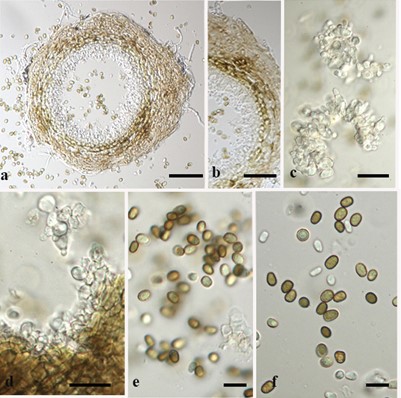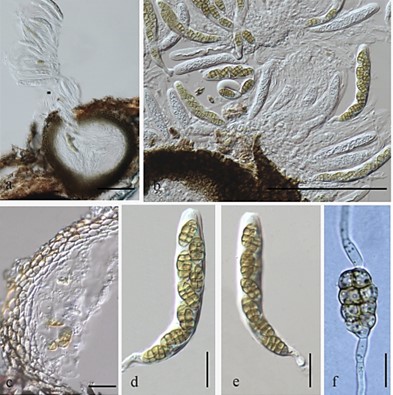Fungalpedia – Note 117 Austropleospora
Austropleospora R.G. Shivas & L. Morin
Citation when using this entry: Fallahi et al., in prep – Fungalpedia, new genera and higher taxa in 2010. Mycosphere.
Index Fungorum, Facesoffungi, MycoBank, GenBank, Fig 1, 2.
Austropleospora was placed in Pleosporales without being assigned to any family by Morin et al. (2010) and was typified by Austropleospora osteospermi R.G. Shivas & L. Morin (synonym: Hendersonia osteospermi Wakef.). Thambugala et al. (2014) reexamined the holotype of Austropleospora osteospermi and based on morphological similarity, placed Austropleospora in Pleosporaceae. Ariyawansa et al. (2015) removed Austropleospora from Pleosporaceae and included it in Didymosphaeriaceae. Austropleospora osteospermi was introduced with both sexual and asexual morphs, and reported for the first time in coastal regions of New South Wales in Australia, on leaf spots of Chrysanthemoides monilifera (an invasive plant), which caused severe necrosis (Morin et al. 2010). The genus also includes three other species; Austropleospora archidendri (Basionym = Paraconiothyrium archidendri) (Verkley, Göker & Stielow) Ariyaw. & K.D. Hyde, Austropleospora keteleeriae Jayasiri, E.B.G. Jones & K.D. Hyde. These two species were introduced with only their asexual morphs, and Austropleospora ochracea L.S. Dissan, J.C. Kang & K.D. Hyde was introduced with only its sexual morph.
Figure 1 – Austropleospora archidendri (photo credits by Jayasiri et al. 2019). a Section through conidioma. b Conidioma wall. c, d Conidiogenous cells. e, f Conidia. Scale bars: a = 50 μm, b = 30 μm, c-f = 10 μm.
Studies based on morphology, host range tests and DNA sequence (ITS) analysis introduced Austropleospora osteospermi as the sexual morph of Hendersonia osteospermi. The genus name is inferred from the Latin word ‘auster’, which refers to its distribution in the Southern Hemisphere and its morphological similarity to Pleospora. Austropleospora osteospermi has perithecioid ascomata with protruding necks that are black, ostiolate, and dispersed throughout the leaves and stems of the host plant. Pseudoparaphyses are filiform, septate, branching, and hyaline. Asci are bitunicate and cylindrical and contain 6-8 ascospores. Ascospores are dictyosporous, ellipsoidal, smooth, and yellowish-brown. Conidiomata are pycnidial, globose, superficial on leaf and stem lesions, with a single ostiole. Conidiophores are absent and conidiogenous cells are inconspicuously annellidic, discrete, and cylindrical. Conidia are cylindrical to narrowly ellipsoidal, initially hyaline and aseptate, becoming yellowish brown, and mostly transversely 3-septate (Morin et al. 2010).SSU, LSU, tef1, and ITS DNA sequence data are available for some species of the genus (Dissanayake et al. 2021; Ren et al. 2022).
Type species: Austropleospora osteospermi R.G. Shivas & L. Morin
Other accepted species:
Austropleospora archidendri (Verkley, Göker & Stielow) Ariyaw. & K.D. Hyde
Austropleospora keteleeriae Jayasiri, E.B.G. Jones & K.D. Hyde
Austropleospora ochracea L.S. Dissan, J.C. Kang & K.D. Hyde
Figure 2 – Austropleospora ochracea (photo credits by Dissanayake et al. 2021). a Vertical section of ascoma. b Pseudoparaphyses and asci. c Peridium. d, e Asci and ascospores. f Germinating ascospore. Scale bars: a, b = 100 μm, c = 10 μm, d, e = 20 μm, f = 5 μm.
References
Ariyawansa HA, Thambugala KM, Manamgoda DS, Jayawardena R et al. 2015 – Towards a natural classification and backbone tree for Pleosporaceae. Fungal Diversity 71, 85–139.
Dissanayake LS, Wijayawardene NN, Samarakoon MC, Hyde KD, Kang JC. 2021 – The taxonomy and phylogeny of Austropleospora ochracea sp. nov. (Didymosphaeriaceae) from Guizhou, China. Phytotaxa 491, 217–229.
Jayasiri SC, Hyde KD, Jones EB, McKenzie EH et al. 2019 – Diversity, morphology and molecular phylogeny of Dothideomycetes on decaying wild seed pods and fruits. Mycosphere 10, 1–86.
Morin L, Shivas RG, Piper MC, Tan YP. 2010 – Austropleospora osteospermi gen. et sp. nov. and its host specificity and distribution on Chrysanthemoides monilifera ssp. rotundata in Australia. Fungal Diversity 40, 65–74.
Thambugala KM, Singtripop C, Chunfang YU, Mckenzie EH et al. 2014 – Towards a natural classification of Dothideomycetes 7: the genera Allosoma, Austropleospora, Dangeardiella, Griggsia and Karschia (Dothideomycetes incertae sedis). Phytotaxa 181, 34–46.
Ren G, Wanasinghe DN, de Farias ARG, Hyde KD et al. 2022 – Taxonomic novelties of woody litter fungi (Didymosphaeriaceae, Pleosporales) from the Greater Mekong Subregion. Biology 11, 1660.
Entry by
Maryam Fallahi, Center of Excellence in Fungal Research, Mae Fah Luang University, Chiang Rai 57100, Thailand.
(Edited by Kevin D. Hyde)
Published online 21 September 2023

